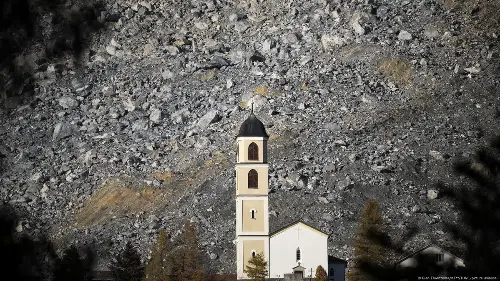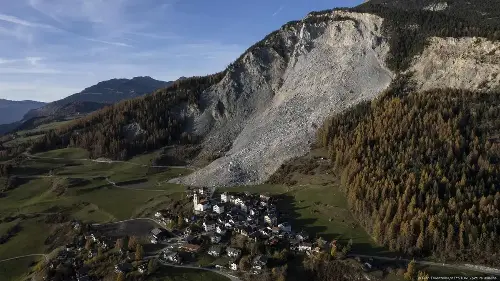
The danger could quickly become fatal: A good 1.2 million cubic meters (42 million cubic feet) of rocky debris could tumble down the valley and bury the Swiss mountain village of Brienz beneath it. The debris is currently moving at a daily rate of around 25 centimeters (9.8 inches) toward the valley.
Last weekend, geologist Stefan Schneider explained to about 90 local residents at an information event that if there were rainfall or rockfall, the speed could increase to 80 kilometers per hour (49.7 miles per hour) or more. He said this was not likely at the time, but if it occurred it would likely not be possible to issue warnings in time.
Local residents were told this week to get ready to evacuate, and warned that they might not be able to return to their homes for months.
"Please prepare yourselves immediately," warned Pascal Porchet, the head of the military and civil protection office for the canton of Graubünden. He told the villagers to take any valuables with them that could not be replaced, as well as whatever they needed for their daily lives.

'A feeling of fear'
"Since this morning there has been a feeling of fear, or perhaps, uncertainty," Arnold von Allem, who has a house in Brienz, told Swiss radio broadcaster SRF earlier this week. On Saturday morning, the authorities informed residents by text message, email and on the social media platform X of the acute danger.
Ursin Bonifazi, a farmer, also spoke with SRF about his concerns. "We are afraid of the evacuation, and we are afraid of the whole process."
Evacuation will prove particularly difficult for those farmers who, like him, have animals. Their livestock must be removed from the pastures or stables, and taken to safety. But it remains to be seen where they can go.
The same question stands for the local residents. Jörg Marguth, who is manning a hotline for those affected, said the municipality and canton would help people find accommodation. But he said most would have to make their own arrangements.
Second evacuation in two years
This isn't the first time Brienz locals have had to leave home. In May 2023, there was the risk of a rockslide and the area remained closed for weeks. A month later, a huge torrent of rock and debris thundered down the mountain, stopping just a few meters away from the old school building.

All the buildings in Brienz were spared, but one road and several meadows were buried under meters of scree and rubble. Residents weren't able to return to their homes until July.
Now, the danger is potentially much greater. While the rocky debris in 2023 fell during a dry period, the rubble is now wet following a bout of rain and is more likely to bury the village, said Schneider. Though a tunnel is currently being built underneath the village to drain excess water at a cost of 40 million Swiss francs (€42 million, $45 million), it is not yet finished.
Insurance only pays in case of total loss
Brienz is located near Davos, where the World Economic Forum takes place every year, at an altitude of around 1,150 meters (3,770 feet). The mountain over the village has been moving for a long time, as cracks in the buildings and the slant of the church tower indicate. The ground beneath the village slides down into the valley at a rate of 2.4 meters (about 7.8 feet) per year.
"That's 20 centimeters a month," said one of the participants at the information event. He said the damage this was causing continued to grow. "Doors no longer close, sewers no longer work, walls, ceilings, floors torn apart. That's my reality."
He also complained that although he had insurance, he would only receive a payout in the event he lost everything. "Security doesn't just mean survival, but also emotional and existential security, and if my house, which is part of my retirement plan, goes down the drain, then I'll have no existential security," he said.
Not due to climate change
According to a recent online commentary in a Swiss newspaper, although climate change is exacerbating erosion this is not the case in Brienz.
After the 2023 rockslide, the geomorphologist Michael Dietze from the University of Göttingen in western Germany said the permafrost in the Alps was thawing as a result of human-caused climate change, but this was happening at an altitude of around 3,000 meters. He said Brienz was too low for climate change to be the cause of this landslide.
Nevertheless, Switzerland is shifting, said Dietze. Processes on the Earth's surface were changing, especially at higher altitudes. Due to rising temperatures, forests were also now growing at higher altitudes, and this was providing more stability. At the same time, however, the permafrost was thawing. And this in turn was leading to more activity between the rock layers at higher altitudes.
This article was originally written in German.